The Main IJN Carrier Torpedo Bomber in 1939-42
The Nakajima B5N was completely unknown by US Intel before 1941, and vastly underrated (like most Japanese aviation, seen as mediocre western copies). Little was known that this model, albeit of the same generation, vastly outperformed the Douglas TBD Devastator, its rival at the time, which in all western publications was proudly accumulating records and “world’s firsts”. The B5N was simply faster and more capable overall. For some authors it was even the world’s best carrier-borne torpedo bomber when WW2 broke out, period. Best proof of that, the “Kate”, much like the “Val” was soon feared in the early phase of the Pacific Campaign, was never truly replaced and fought on the frontline to the end.
Distant Origins
The first Japanese aircraft were imported until by 1918, Lieutenant Chikuhei Nakajima resigned to establish his own aviation company in Ota, Gumma Prefecture in assoviation with Seibei Kawanishi, but they disagreed, both later creating their own companies. Chikuhei Nakajima went on with licensed aircraft but still worked on a proper model to fill both Army and Navy competitions. In 1921, Captain Sempill, with thirty British instructors were invited to evaluate the technical needs of the young JNAF. Herbert Smith (from Sopwith) was found at the head of Mitsubishi, soon creating the mediocre Type 10 torpedo bomber, entering service in 1923 on IJN Hosho. At the time all but a young Captain Yamamoto at the Kasumigaura Naval Flight Aviation School predicted their need over battleships.
Until 1929, development was still slow, as doubt prevailed for further development of the Naval Air Force (a similar downhill battle was led by Mitchell and his supportsr in the US). What did’nt helped to convince the general staff was the poor performance of early models. But the help of foreign advisers (another good example was Kawasaki’s Vogt, Mitsubishi’s Petty from Blackburn), helped Japanese designers gaining experience, and after purchasing whole series or planes to assemble, single examples were purchased for comparative tests, copying all features along the way. This was well known by the Western world that long believed the Japanese cannot do anything else but poor copies, until December 7th, 1941.
Captain Yamamoto however, back from his srtay at the Washington embassy, promoted vice admiral started to head the Naval Aviation Technical Bureau, pushing new models more in line with his scenario of naval warfare across the Pacific. This proces, started in 1931, and also concerning many other aspects like training and ordnance, ended in 1941, making at that tomùe the IJN probably the most powerful and efficient naval air force worldwide. Transitional fighters (9-Shi program) led to the excellent A6M “Zero”, while the dive bomber bomber led to the dreaful Type 99 (Aichi D3A “Val”) but Yamamoto insited for a for long-range land-based naval bombers as well (Mitsubishi G3M “Nell”, Mitsubishi G4M “Betty”) and for torpedo bombers wanted to replace the mediocre Type 89 (Mitsubishi B2M) for 1936, leading at first to the Type 96 Yokosuka B4Y, still a biplane limited to 277 km/h and 1,574 km. In 1937 already this was considered whoelly unsuficient.
A year prior however, in 1935 the 10-Shi specification were published, pushing the boundaries of what was capable for a modern torpedo bomber design. Performance were to be several fold higher, leading to the Navy to trust only two firms to came up with a solution: Mitsubishi and Nakajima, answering and soon retained. The programme at Nakajima was headed by Katsuji Nakamura’s team.
Design development
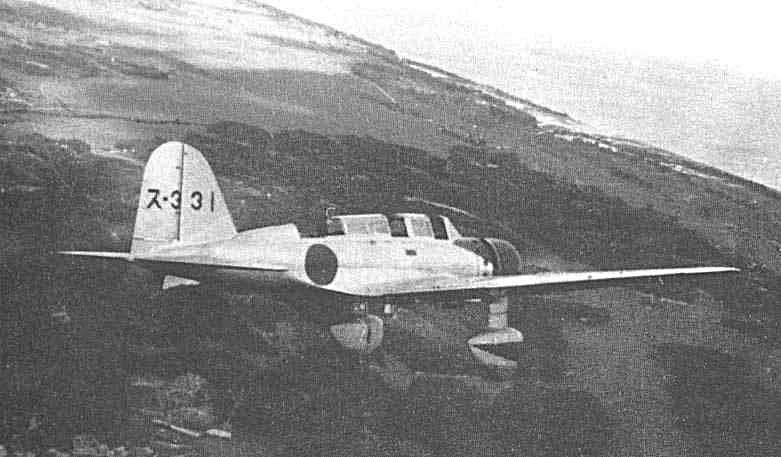
Mitsubishi B5M, it’s loosing competitor
The B5N was designed Katsuji Nakamura to replace the previous biplane, barely into service, internally designated as the “Type K”. 10-Shi specs for a naval carrier-based strike bomber called for 330 km/h top speed (min figure) that no biplane could match. Indeed at the time, the Mitsubishi’s A5M already reached 449 km/h and showed what a monoplane can achieve. The admiralty though was aware of yaw control in the last stages of the landing approach and was worried about achieving enough landing accuracy. Discussions led to think this issue of speed could be overcome by the use of flaps, a novelty rediscovered from WWI.
Mitsubishi studied with great attention the American Northrop BT bomber, which was imported in 1935 from the USA. It had a retractable landing gear and powerful engine, more than the Northrop A-17 “Shrike”. The latter also inspired the Kawasaki Ki-32, Mitsubishi B5M and Mitsubishi Ki-30. Douglas turned these into the TBD Devastator and SBD Dauntless and so Jiro Horikoshi believed these were to watch with great attention.
Meanwhile Nakajima worked around a new 840-hp Nakajima Hikari 2 radial engine, woven into a low-drag NACA cowl its new model also comprised a serie of innovative features like a hydraulically retractable landing gear. It was the first time such hydraulic system was created in Japan and issues were many. To overcome them took time though and Mitsubish translated this later into the 12-Shi spec program (A6M).
Meanwhile both also worked to have the new aircraft fitting inside always low and narrow carrier hangars, and ways to fold and maintained in flight the wings. Soon a rotary nodes system was created, in which wing consoles overlapped one another and power brought by Hydraulic cylinders placed in each wing. Also worked out for quite long was the trailing edge of the wing, and the designe of a more modern three-bladed variable pitch propeller.
First flight
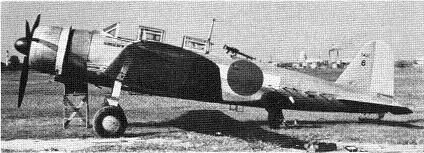
Kate tested by the USN, US Navy (R. Francillion coll.)
The Type K prototype made its first flight in January 1937. She was able to reach 370 km/h in level flight, a record at the time for a torpedo-bomber. However as the full folding mecanism was not ready yet, trials urged the use of a lever inserted by a technician into the lower surface of the wing console. The Fowler-type flap mechanism was too advanced and not ready so it was replaced by a simplified device in which the entire trailing edge section turned. The variable pitch propeller also proved to be complex and was replaced at the last minute by a constant speed propeller. The second prototype had to be fitted with integral fuel tanks were inside the center section.

A parralel development, the Nakajima C3N (1936)
For the second prototype also, a new engine was adopted, the 770 hp Hikari 3 which presented the advantage of easy of removal and replacement. The definitive engine hood was well-rounded and the nose short, in full contrast to following models. After the first factory flights (the very first was made in January 1937), the Nakajima led the competition as opposed to the Mitsubishi B5M. It was ordered into production soon afterwards, under the full designation “Type 97 Carrier Attack Bomber”.
Competition won by Nakajima
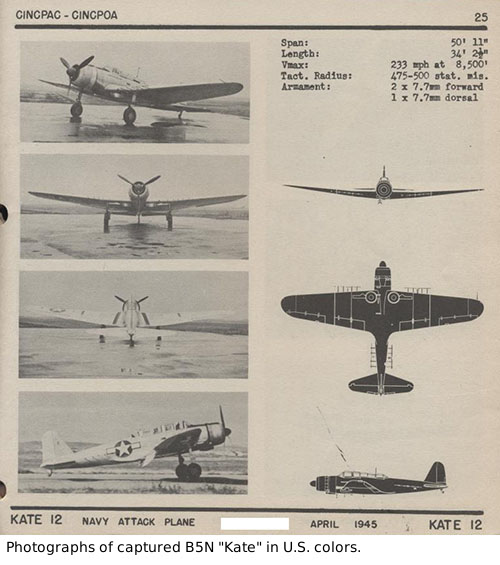
ONI plate, B5N, CINCPOA, US Intel
The Mitsubishi 10-Shi answer was very similar, but more conservative in its technical approach, with a more elliptical wing, in part based on the Type 97 fighter, itself inspired by the Heinkel 77. However, the landing gear was non-retractable and it had prominent fairings, while the wings were originally manually folded. The engine, the 1000-horsepower Mitsubishi Kinsei had better takeoff stats than the Nakajima design maximum speed reached being 378 kph, ten more than the Nakajima’s 368 km/h.
However in the end, the admiralty decided not to produce this aircraft: Despite its better perforamnces caracteristics, the Nakajima design was chosen for production in standard, related to its greater development potential and more advanced technical solutions. The second reason was that Mitsubishi’s design staff was already struggling to modificaty the Type 96 naval carrier-based fighter and was involved in the 11-Shi specification calling for a dive bomber (won by Aichi with its D3A) while working on the 12-Shi program fighter (future Zero). In 1937, the admiralty nevertheless ordered 125 of the Mitsbishi model designated B5M1. Designated Type 97 Model 2 naval carrier-based strike bomber, the allies would codename these “Mavis”. It was mostly used as a land and naval carrier-based attack bomber for anti-submarine patrols in South China and Hainan and was gradually retired after 1943.
Final design
The pilot sat in front of the cockpit but forward visibility was reduced while on the ground, a common issue at the time on these tail down models. It was in part due to the high wheeltrain legs in relation to the cumbersome torpedo below. It was ensured it’s tail would not hit the deck. However it was also assumed that for landing, the latter would have been launched or jettisoned anyway.
Good visibility nevetheless for the final approach and deck operations to e machanism helped raising the seat on both phases so that his eyes could be at the top of the visor binding. Simple instruments for blind flight were also added. The second member of the crew was the navigator, weapon officer and observer, located in the second seat further down in the cockpit and facing forward, exiting or entering though a sliding window on both sides. he acted also a auxiliary mechanic as his dashboard showed fuel consumption in an indicator gage on top of the center-section fuel tanks, located on the wings. For dropping bombs, he could removed the two seat’s floor hatch panels and access a ledge to the left of the torpedo/bomb suspended under the fuselage. The last member was the radio operator which doubled as rear gunner, seaying while facing rearwards, accessing his machine gun stored inside the fuselage but which could be erected after the rear canopy was moved back. Early radios modls though were of the low frequency and needed a long towed antenna.
Communication between crew members were done using still an old style speaking pipe, and oxygen equipment was purely optional even though the high altitude this model could achieve. This made it simpler and cheaoper as well, but also much lighter, something all designers in Japan tried to achieve. They all wore life jackets of a very inefficient design and hot furred aviator leather combis.
Design in detail
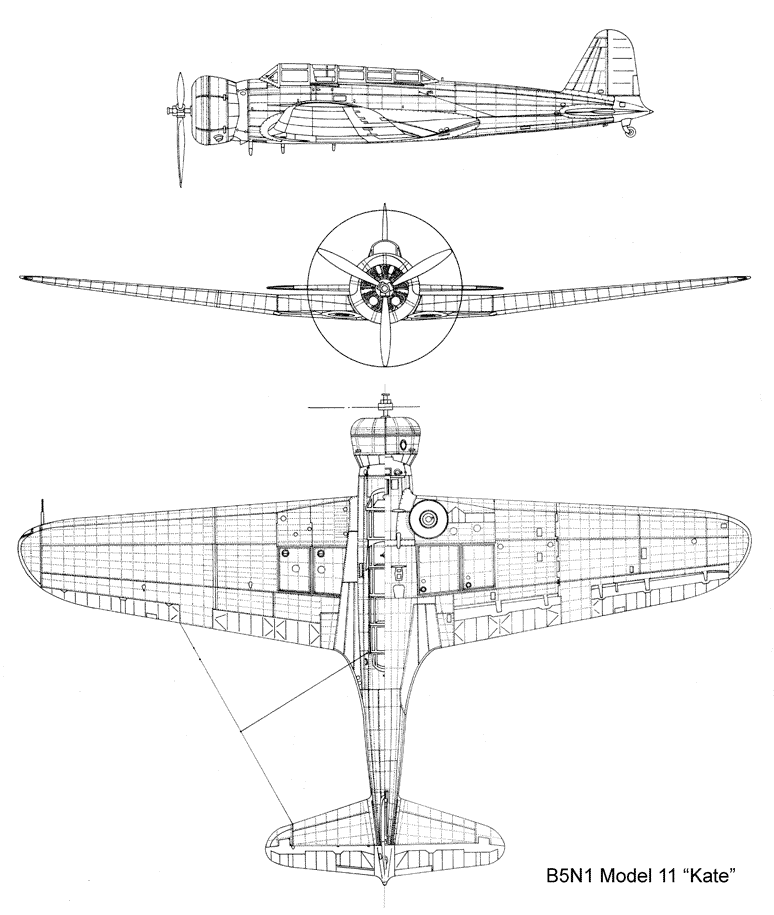
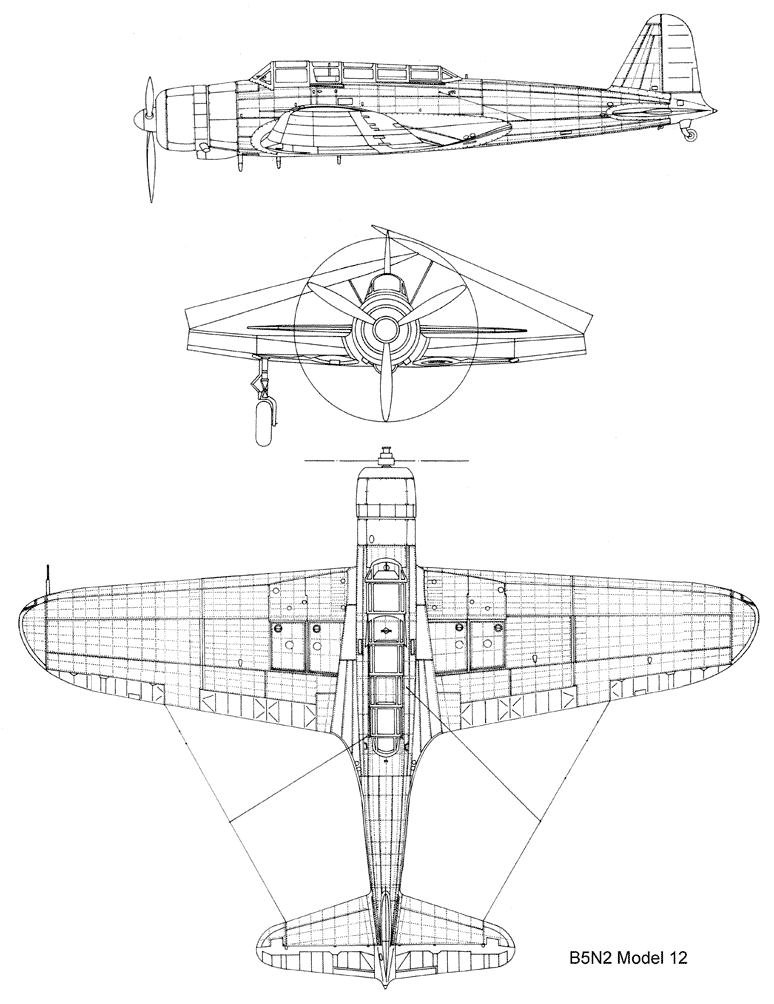
Comparison betwen the Nakajima Type 11 and 12.
General construction
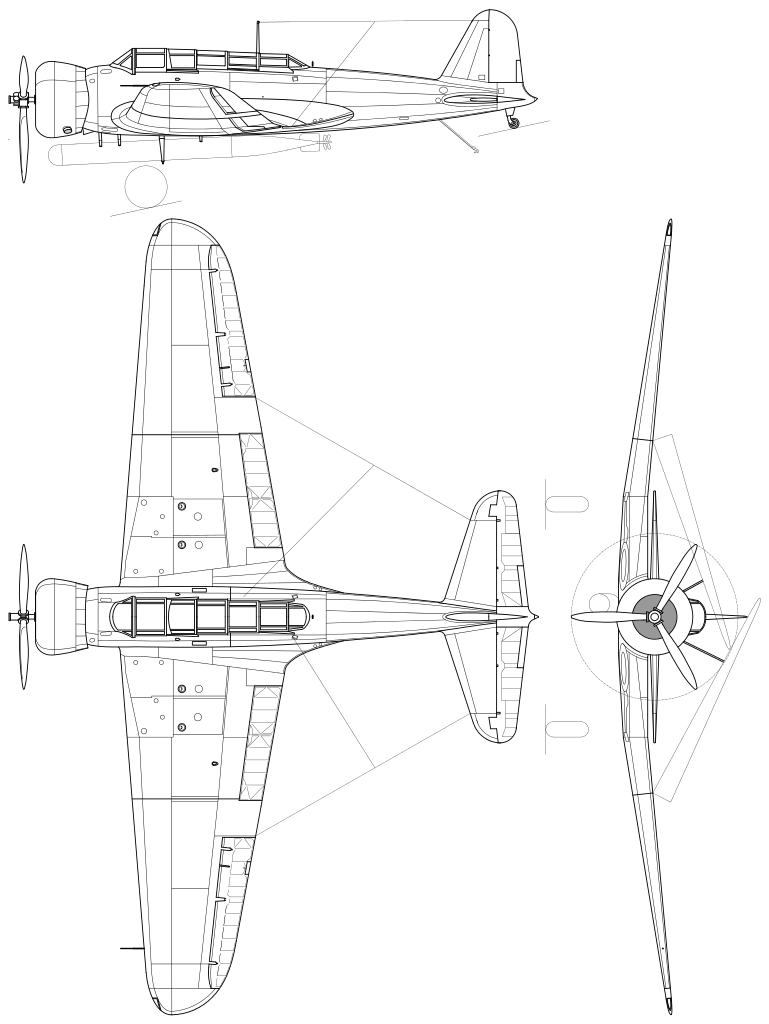
blueprint
Single-bay fuselage, with an all-metal stress skin, mostly welded and of duralumin. It was semi-monocoque with tubular sections. There was a release system for a towed antenna on the B5N1, but the B5N2 instead had a wire antenna stretched from one top of the cockpit to the top of the tail. Longerons as well as partial rear fuselage sections were skin-covered. It had relatively large wings suitable to carry a large payload, but causing drag and therefore reducing both speed and agility. Dimensions were reduced as weight leading to a very light design compared to the USN Devastator. The hope was to out-run opposition, so protection was absent. Fuel tanks were not self-sealing at first and there was no armor plating to protect the pilots’s heads.
The two-spar wing had a manual folding system and the right one folded first so that it layed below the left, one on top of the cockpit, supported by auxiliary struts. The slotted flaps were placed up to the wing folding hinges and ailerons with linen cover, were located outside. They had built-in fuel tanks behind the upper and lower wing lining, placed between the main and rear spars of the center section, attached with edges brackets. Trim tabs were provided on horizontal and vertical rudders.
The hydraulically retractable main undercarriage mounted under the wings had each leg fitted with an oil-damper type shock absorber reinforced by a forward bending strut. When retracted the wheels were turned 90° to fit inside the wings. The tail wheel was non-retractable and cast. The retractable landing hook was mounted ahead of it. It was sprung by a coil spring when landing to extent downards and retracted before taking off in its tensioned position.
The B5N was caracterized by its long glass cockpit, protecting a three-seat crew: The pilot, the navigator/bombardier/observer seated beind, and a radio-operator/gunner at the rear. Like with other IJN multi-seat aircraft, it was commanded by a senior ranking crew member, more often the observer, which directed the flight. This combination was important to deliver strikes in the middle of the pacific. Despite the lightness of its structure, the B5N was sturdy enough to make rough landings, equipped with a stable, large span landing gear, folding inwards. The wings had as straight section up to 1/3 of their lenght, then followed by an upwards section, with the folding cuts about 40% of the total lenght. A pair of small doors in the floor of the second crew member opened through the lower surface of the left wing root for visual aiming during bombing.
The B5N had a right-mounted pitot tube for flight data, an underwing mounted antenna, and main radio antenna placed at the rear, above the radio set. The radio operator seat was in fact a rotating stool, allowing him to turn back towards the tail to man the defensive machine gun. The navigator was seated more conventionally, and facing forward. The overall cockpit was not roomy however. Overall, the B5N looked right and very modern for its time, but its output was not sufficient to out-run fighters as expected, with a top speed of just 320 kph at best, most late 1930s Chinese fighters could catch it.
Engine & performances
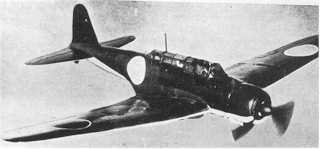
Equipments
The navigator/bombardier/observer was given a Type 90 bombsight, a long vertical tube, located in the front-left of his seat. He also had a Type 3 reflector compass, for precise navigation over the Pacific. It was mounted on top of the cockpit frame. He also had at its disposal a standard-issue radio set, Type 96 Mk3 for the B5N1 and Type 2 Mk3 on the B5N2. It was placed in front of the operator/rear gunner, behind the navigator/bombardier/observer’s seat.
Armament

Very early production Type 97 model 1 in 1938
The B5N1 carried a forward machine gun armament for strafing an possible attack in flight, two 7.7 Type 97 machine guns in the wings. But it was not the case for all. In fact many went just equipped with a defensive armament only, a single flexible-mounted 7.7 mm (.303 in) Type 92 machine gun.
The main use of the B5N was its Type 91 torpedo carried underbelly. It was mounted under racks were fixed eccentrically, to the right-bottom of the fuselage. They could be replaced for a model supporting a 800 kg bomb (Like the Type 99 No 80 armor-piercing bomb also used by the “Val” with devastating result, but in that case, dropped in level-bombing) or two 250 kg bombs (Type 98, No 25) or six smaller 60 kg bombs (Type 2 No 6). Replacing racks however was a two hours long process to complete, which cost the admiralty dearly at Midway…
Production & succession
Combat experience during the Second Sino-Japanese War revealed weaknesses in the original B5N1 design, notably the lack of protection for bth the crew and fuel tanks. The Navy however preferred to add more power to the model to out-run opposition rather than taking punishment, leading to the B5N2 equipped with the Sakae Model 11, 14-cyl. twin-row radial also used on the initial A6M fighter. Performance ended only marginally better, but it was produced anyway from 1939 at an increased rate until 1943, a long production run for a 1937 design.
Work on improving performances of the B5N1 continued so that in December 1939 already the B5N2 powered by a Nakajima Sakae two-row radial engine and revised cowl seemed a wnning formula, and other design changes included a modified antenna above the rear cockpit. Known at first in ordnance as the Type 97 Model 3 Naval Carrier-Based Attack Bomber, it became the Type 97 Model 12 in accordance with the new model designation system. In December 1941, it was already replacing the B5N1s onboard aicraft carriers, although both models took part in the Pearl Harbor attack.
Nakajima Aircraft Company produced alone 1,149, the production run ceasing in mid-1943 with the B5N2. The B5N was to be replaced by the B6N Tenzan “Jill” which first flew in March 1941, but development dragged on and it was only ready in August 1943, introduced and produced until 1945, so only available in numbers in 1944. More were produced, 1,268 in all but their battle records were certainly less brillant.
Itself was to be replaced by the Aichi B7A Ryusei “Grace” (Nakajima lost the competition to its rival). It first flew in May 1942 after a seemingly impossible spec of 1941 to replace both the B6N and D4Y, so having a universal torpedo/dive bomber for the new light carriers (with reduced air groups) potentially built by the IJN after 1943. However the Aichi B7A development proved complicated and it was only produced from late 1944, to 114 units only, most seized in Japan after the war has ended, and with practically no carrier left to carry them. The last variant B7A3, never built, was planned with a 1641 kW (2,200 hp) Mitsubishi MK9A engine, twice as powerful as the “kate”.
- Type K: 1937 factory Prototype.
- B5N1: First production model of 1938.
- B5N1-K: 1944-45 conversion into advanced training aircraft.
- B5N2: Improved main production version from 1939.
Detailed specs
Nakajima B5N2 (1939) |
|
| Crew: | 3: Pilot, navigator/bomber, gunner/radio |
| Fuselage Lenght | 10.3 m (33 ft 10 in) |
| Wingspan | 15.5 m (50 ft 11 in) |
| Wing area | 37.7 m2 (406 sq ft) |
| Height | 3.7 m (12 ft 2 in) |
| Airfoil type | NN-5 mod. (16%); tip: NN-9 mod. (8%) |
| Empty weight: | 2,279 kg (5,024 lb) |
| Max takeoff weight: | 4,100 kg (9,040 lb) |
| Propeller: | 3-bladed metal propeller |
| Engine: | Nakajima PE NK1B Sakae 11, 14-cyl. ACR 1,000 hp TO or 970 hp at 3,000 m |
| Top speed: | 378 km/h (235 mph, 204 kn) at 3,600 m (11,811 ft) |
| Climb rate: | 6,5 m/s (1,280 ft/min) |
| Range: | 978 km (608 mi, 528 nmi) or 1,991 km (1,237 mi, 1,075 nmi) straight |
| Service ceiling: | 8,260 m (27,100 ft) |
| Time to altitude: | 3,000 m (9,843 ft) in 7 minutes 40 seconds |
| Power/mass: | 0.196 kW/kg (0.119 hp/lb) |
| Wing loading | 100.8 kg/m2 (20.6 lb/sq ft) |
| Armament | 1-3x 7.7 mm (0.303 in) Type 97 MGs, 1 torpedo/800 kgs bomb, see notes |
The B5N “Kate” in action
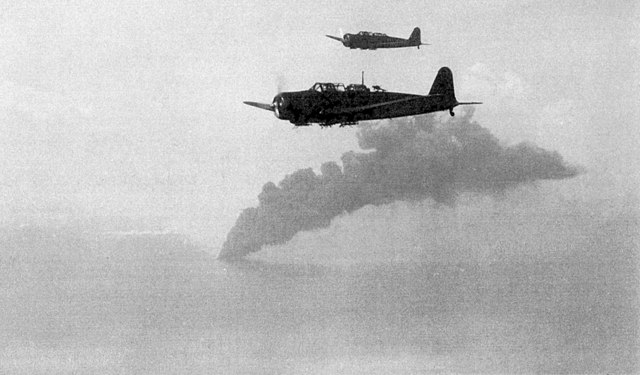
B5N2 over the Java sea, February 1942
On December 7, 1941, the western world reminded the “Never underestimate the enemy” motto first coined by Sun Tsu. The yet completely unknown or dismissed Nakajima B5N first appeared to Pearl Harbor an her rampage would go on for most of the Pacific War.
The B5N, codenamed “Kate” by ONI in 1941 was primarily deployed as a carrier-based aircraft, but later in the war as a land-based bomber. The B5N1 first saw action in the Second Sino-Japanese War, from 1938. There, default were recoignised but the IJN wanted more speed, not protection. These combat debut were as land-based aircraft, and in support of the Army operating in Hankow. In the autumn of 1940 under forced agreement with the Vichy government, French Indochina was dotted with bases operating B5N2s, used for bombing Chiang Kai-shek troops in southern China. The B5N2 introduced in 1939 became by far the largest production of the tyme, playing a major role at Pearl Harbor and all subsequent engagements of the IJN until the situation started to reverse.
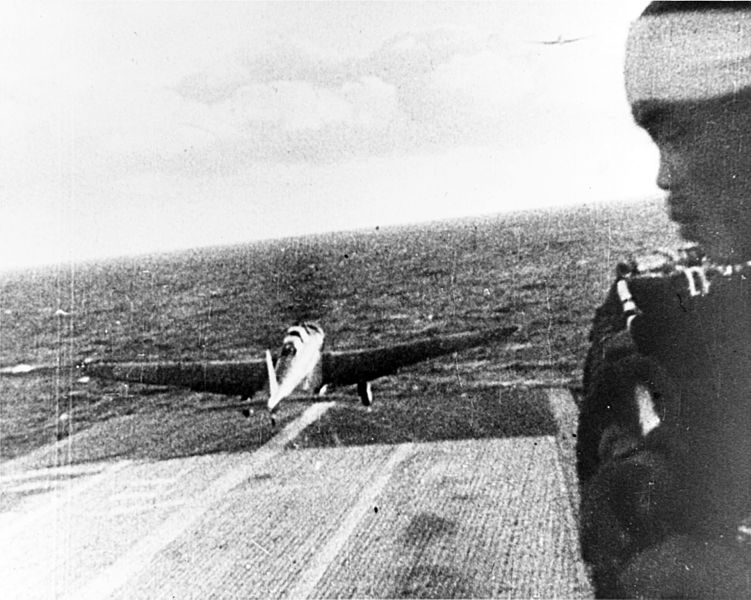
A B5N takes off from IJN Shokaku for the Pearl Harbor attack
In November 1940 the Taranto pushed Minoru Genda, later recalled by Admiral Yamamoto to propose a similar surprise attack on Pearl Harbor. For this, the Type 97 was however to be armed with special torpedoes due to the local shallow waters. They were equipped with wooden tails, forcing them to stay close to the surface after launch. Armor-piercing bombs being in short supply and reeserved to the “Val”, B5N2s used as bombers were given 16-inch naval shells with welded stabilizers instead, becoming 800-kg bombs.
After training in the Gulf of South Kyushu, these B5Ns distribited among Kido Butai’s six aircraft carriers under orders of Admiral Nagumo gathered in Tankan Bay, Kuriles Islands and sailed from 28 November. In all, Genda had at its disposal some 353 aircraft, launched in two waves. They left the carriers in the monring early hours of December 7, B5N2 armed with bombs under command of Mitsuo Fuchida. 50 took part in the first wave, alongside 40 B5N1 with torpedoes led by Lieutenant Commander Shigeharu Murata. The attacked commenced at 7.49 AM. It was highly successful. A second wave later included 54 B5Ns fitted as bombers. It was all over at 8.30 and only five B5N2 were lost. Stats shown they had some 30% direct hits from torpedoes, 27% from bombers, the payoff of months of intensive training.
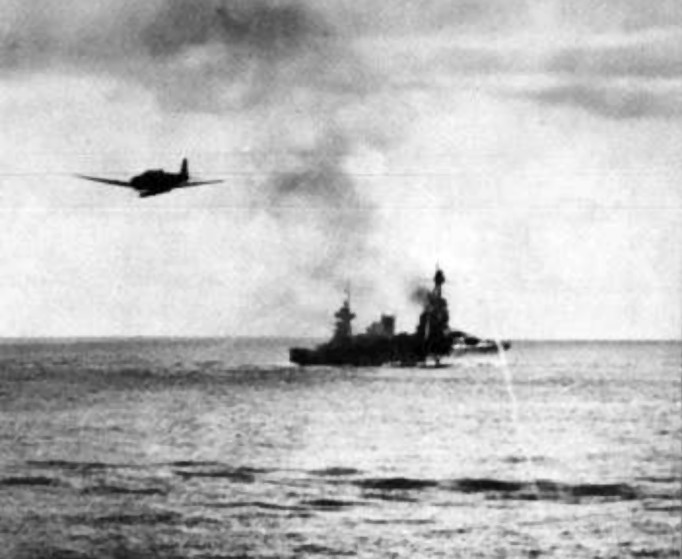
A B5N2 passes close to USS Noprthampton at the battle of Santa Cruz Islands.
In early 1942, Nagumo assaulted the Dutch East Indies, and this costed the British among others the loss of the Dorsetshire, Cornwall and Hermes, by B5N2s and D3A2s (Type 97 and Type 99). B5N2s also sank the aircraft carrier USS Lexington at Coral Sea, and USS Hornet at Santa Cruz Islands. B5Ns also nearly sank USS Yorktown at Midway, finished off by I-168 later.
B5N2s crews were trained in coordinated attacks on enemy carriers with the Aichi D3A dive bombers. Dive bombers weere the first to act, trying to suppress the ship’s AA or daw it to them, allowing the slow flying “kates” to make their torpedo run to target, very low-flying. At the Battle of Eastern Solomons, the IJN initially sent only dive bombers to enable a later torpedo strike but this tactic proved unsuccessful: They did not launch until the battle was over.
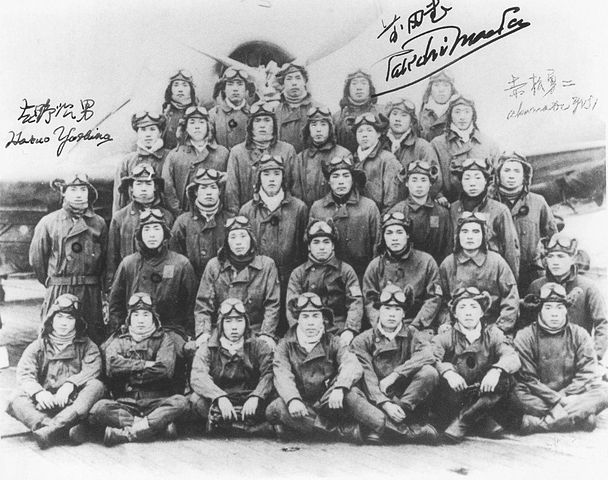
Pearl Harbor: Akagi’s B5N crews
The IJN had operated with almost no effective countermeasures and gambled all on the first major air strike. This was their undoing at Midway. Later Ryujo and Junyo were to strike at the Aleutian Islands, Akagi, Kaga, Soryu and and Hiryu meanwhile hitting Midway and on 5/7/42, two waves of B5N2 bombers hit Midway Island. However that day they lost 50% of their trained crews and never recovered from this. Eastern Solomons, Santa Cruz, and Guadalcanal drained aircraft and crews, which the remainder took refuge in Truk. Carrier battles were absent of 1943, B5N2s were used from land bases: Buin and Kolombangara (Solomons) for punctual strikes, made difficult by the increaing numbers of ships and excellent AA. Also in 1943 with the new Essex-class carriers came the Hellcat, which had no issue downing the slow B5N2 in droves.
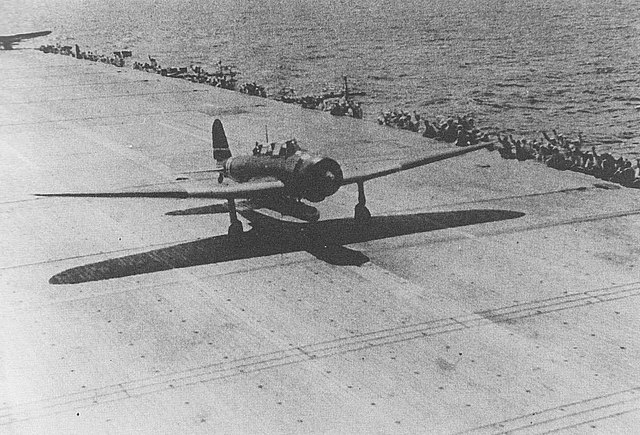
B5N2 taking off from IJN Zuikaku at Coral Sea, May 1942
By 1944, the Corsair also became the B5N nightmare, but the latter became increasingly rare. The “Jill” started to replace them on various bases and they were gradually retired to the home islands. The Marianas and the Battle of the Philippines on 19 June signed the loss of 1,600 aircraft and 3 aircraft carriers and many B5Ns. However in October 1944 the first kamikaze attacks started and the battle in Leyte Gulf, in which mpore and more battle-worn “Kates” flew with inexperienced pilots as Kamikaze. Some were still around in this guise at Iwo Jima and Okinawa. The last took hoff from Kyushu in the sumer of 1945
General Assessment
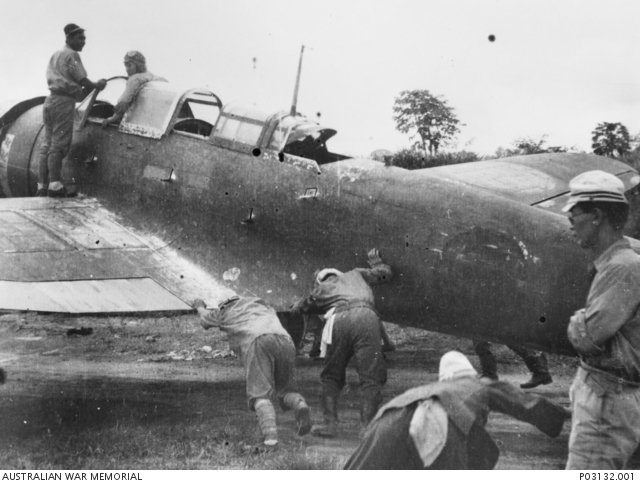
B5N2 in Rabaul
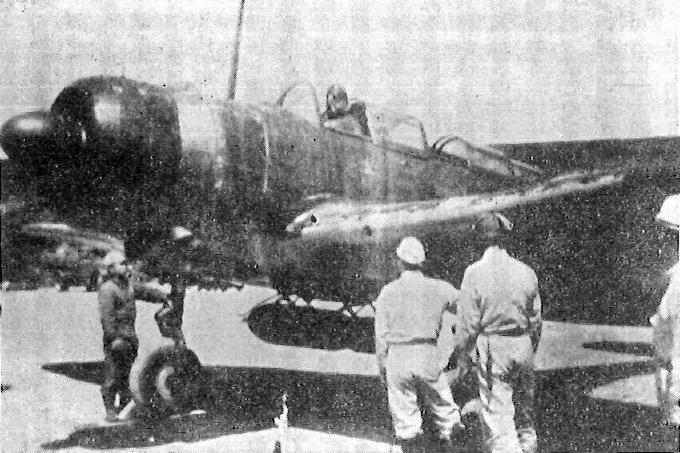
B5N Kate on Kataoka Airfield, Shumshu Island
The trio, A6M2 (“Zero”), D3A1 (“Val”) and B5N2 (“Kate”) paralleled the USN F4F-3 Wildcat, SBD-3 Dauntless and TBD-1 Devastator and all had a performance advantage but perhaps for the Dauntless. The British Fleet Air Arm models, after years of peacetime neglect, were hopelessly behind: The Fulmar, Skua and Swordfish were just not fit to survive in the Pacific. When in 1943 this early trio changed for the new combination F6F Hellcat, SB2C Helldiver and TBF Avenger, the “Zero” was never replaced, and the B5N2 stayed in frontline until the summer of 1944.
Frantic work to replace the B5N2 eventually culminated in the B6N1 Tenzan (“Heaven’s Peak”) which was prepared for trials in March 1942, powered by a 1870 hp oversized Nakajima Mamori engine, but plagues with vibration problems forcing replacement for a Mitsubishi Kinsei, as the B6N2 (“Jill”) and absent of the devastating Marianas battle of June 1944. In the Philippine Sea, carrier-based aircraft like the “Jill” mostly were used only from land bases.
The remaining B5N2s received an anti-ship radar to stay relevant, its with antennas along the sides of the fuselage enabling anti-submarine patrols in all weather conditions or night. These pilots expertly flew their machine, forced by the primitive detection system, to just 9-12 meters above the surface. They carried up to 283.5-kg bombs with delayed fuses, acting like depht charges and exploding at a set depth. In 1945, the last B5N2s still serviceable were still used to tow gliders and targets in the home islands.
References
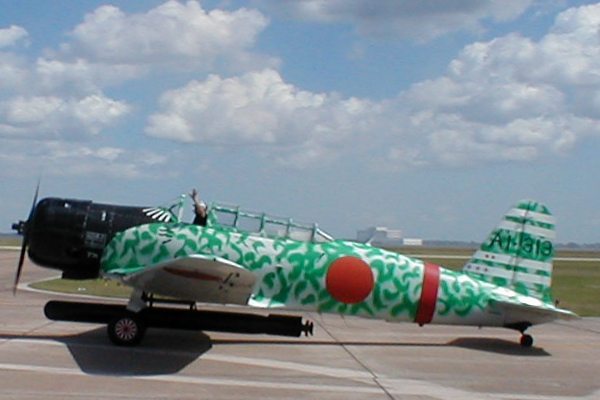
A B5N replica as of today, made from an AT-6 Texan, heavily modified.
Japanese Aircraft of the Pacific War ” /Rene J Francillion.
“Japan Warplanes of World War II” /Oleg Doroshkevich
Angelucci, Enzo and Paolo Matricardi. World Aircraft: World War II, Volume II (Sampson Low Guides). Maidenhead
Chambers, Mark A. (2017). Nakajima B5N ‘Kate’ and B6N ‘Jill’ Units. Vol. Combat Aircraft #119. Osprey Publishing.
Francillon, René J. Japanese Aircraft of the Pacific War. London: Putnam & Company Ltd., 1970
Francillon, René J. Japanese Bombers of World War Two, Volume One. Windsor, Berkshire, UK: Hylton Lacy Publishers Ltd.
Lundstrom, John B. (2005a). The First Team: Pacific Naval Air Combat from Pearl Harbor to Midway (New ed.) NIP.
Lundstrom, John B. (2005b). First Team and the Guadalcanal Campaign: Naval Fighter Combat from August to November 1942
Mikesh, Robert C. (2004). Japanese Aircraft Equipment: 1940-1945. Schiffer Publishing.
Parshall, Jonathan and Anthony Tully. Shattered Sword: The Untold Story of the Battle of Midway. Potomac Books
Tagaya, Osamu (2003). Imperial Japanese Naval Aviator 1937-45. Osprey Publishing.
Tagaya, Osamu (2011). Aichi 99 Kanbaku ‘Val’ Units of World War 2. Botley, UK: Osprey Publications.
combinedfleet.com
pearlharboraviationmuseum.org
List of airfoil designations
warbirdsnews.com
wingsmuseum.co.uk
airwar.ru
airpages.ru
wiki
On The Pacific War Online Encyclopedia
electraforge.com

Nakajima B5N1 12th Kokutaio, China 1938-39, one of the first operator. Denomination Donation Slogan Hokoku 268 “Tokyo Kikai-Go”

B5N1, 14th Kokutai, Sanzai Dao, with its Chinese camouflage, Southern China 1939

B5N1 Model 11 14th Kokutai China 1938-39

B5N1 at the Yokosuka Naval Air Base for training, 1940

B5N1 at the Konoe Naval Air Corps training unit, 1941

Nakajima B5N-1 from the 4th Kokutai, IJN Ryujo, 1941

B5N-1 IJN Zuiho, February 1942

B5N-2, IJN Shokaku, December 1941, Pearl Harbor Attack

B5N-2, IJN Zuiho, Battle of Santa Cruz, October 1942

B5N2 IJN Soryu Central Pacific Dec. 1941

B5N2 1st Koku Kantai, IJN Akagi, Pearl Harbor, 7 Dec. 1941

B5N2 IJ Zuikaku Indian Ocean Raid 1942

B5N2 Lt. J. Tomonaga IJ Hiryu Central Pacific June 1942

B5N 2 on Saipan, June 1944
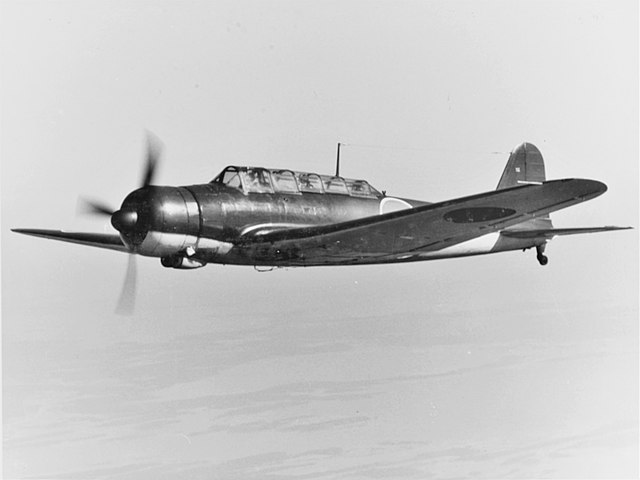
BH2 in flight – Green coll.
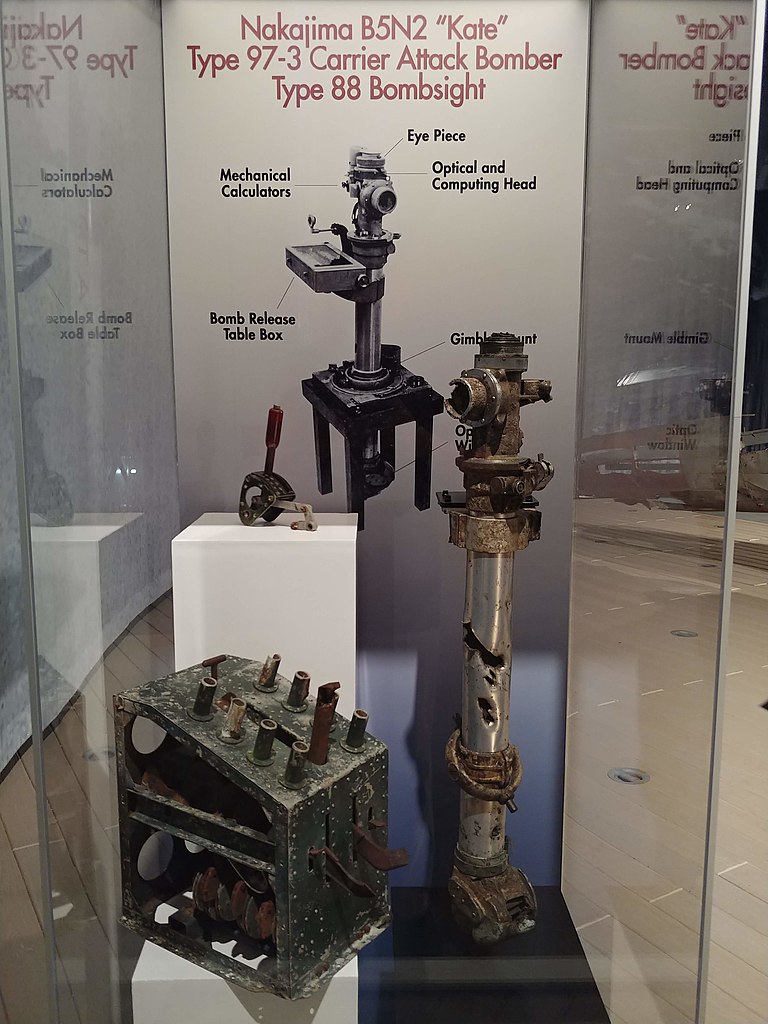
Type 55 bomb sight and torpedo release system
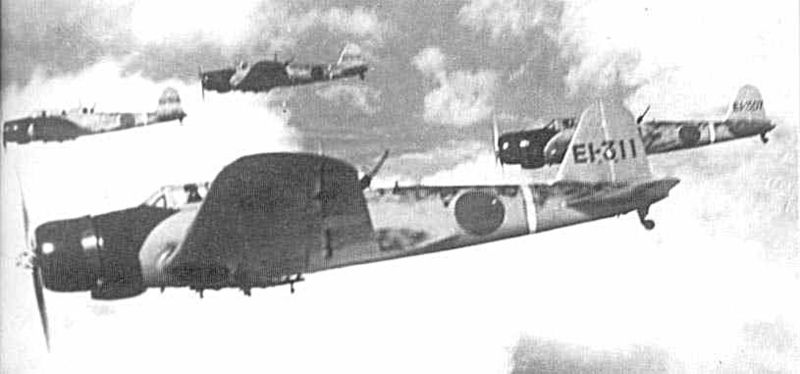
A Formation of B5N-1 from IJN Akagi in 1941

Nakajima B5N2 “Kate” carrying 250 kg (550 lb) bomb.
movie extract, “Hawai Mare oki kaisen (The War at Sea from Hawaii to Malay)” (1942).
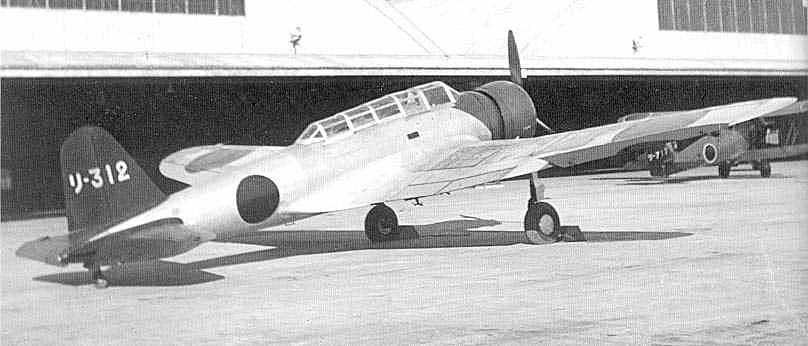
B5N in flight

B5Ns over the Java Sea February 1942

Captured B5N with US markings, TAIC

Type 97 in flight

B5N1 aboard IJN Akagi with a dummy torpedo

B5N in flight

B5N2 in flight
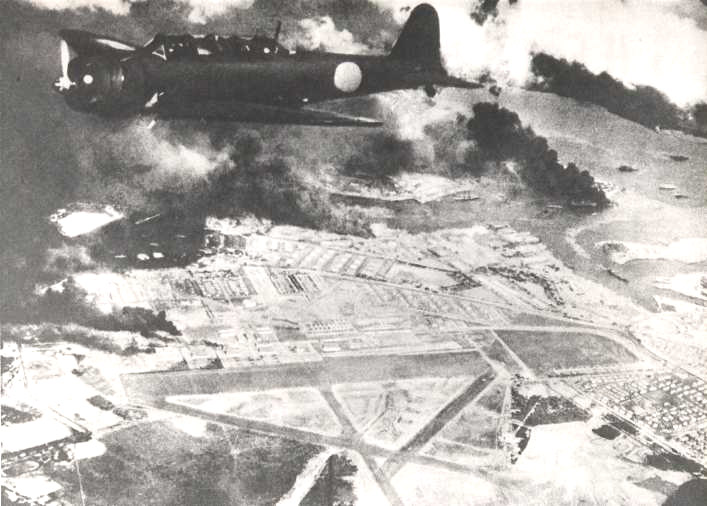
B5N2 over Hickam field, Pearl Harbor
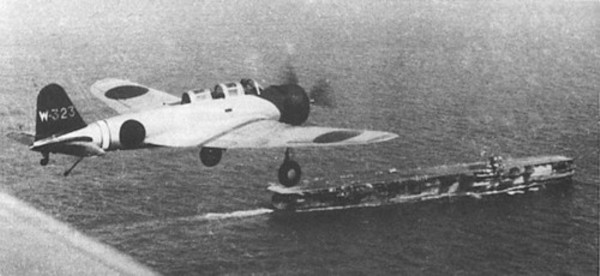
B5N1 from IJN Soryu in 1939
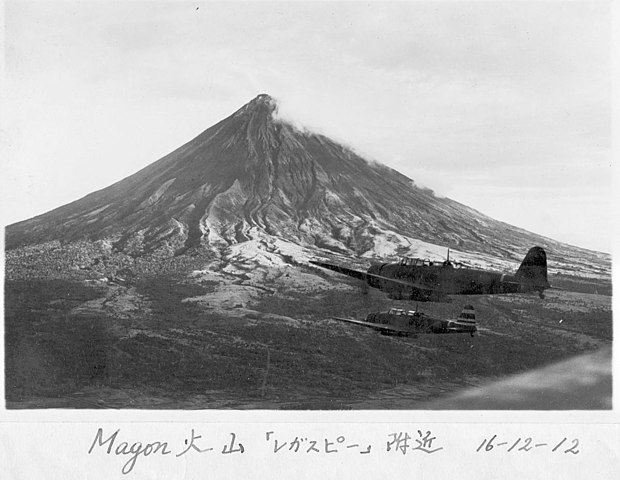
Type 97 from IJN Ryujo in front of Mayon Volcano near Legaspi in the Philippines. On Showa 16 (1941) Dec 12th, 4 days after Pearl Harbour.
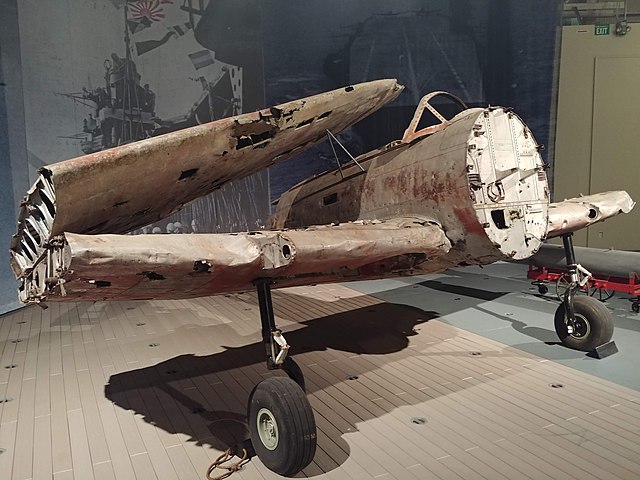
Surviving “Kate” in reconstruction at PHAM
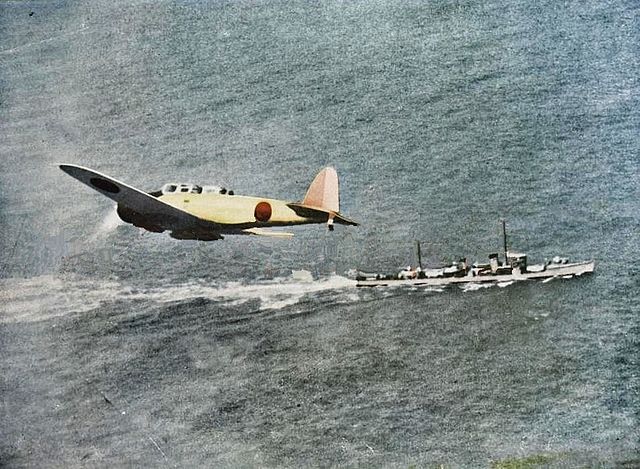
Colorized photo, B5N and destroyer, South Java Sea. 1942


 Latest Facebook Entry -
Latest Facebook Entry -  X(Tweeter) Naval Encyclopedia's deck archive
X(Tweeter) Naval Encyclopedia's deck archive Instagram (@navalencyc)
Instagram (@navalencyc)





 French Navy
French Navy Royal Navy
Royal Navy Russian Navy
Russian Navy Armada Espanola
Armada Espanola Austrian Navy
Austrian Navy K.u.K. Kriegsmarine
K.u.K. Kriegsmarine Dansk Marine
Dansk Marine Nautiko Hellenon
Nautiko Hellenon Koninklije Marine 1870
Koninklije Marine 1870 Marinha do Brasil
Marinha do Brasil Osmanlı Donanması
Osmanlı Donanması Marina Do Peru
Marina Do Peru Marinha do Portugal
Marinha do Portugal Regia Marina 1870
Regia Marina 1870 Nihhon Kaigun 1870
Nihhon Kaigun 1870 Preußische Marine 1870
Preußische Marine 1870 Russkiy Flot 1870
Russkiy Flot 1870 Svenska marinen
Svenska marinen Søværnet
Søværnet Union Navy
Union Navy Confederate Navy
Confederate Navy Armada de Argentina
Armada de Argentina Imperial Chinese Navy
Imperial Chinese Navy Marinha do Portugal
Marinha do Portugal Mexico
Mexico Kaiserliche Marine
Kaiserliche Marine 1898 US Navy
1898 US Navy Sovietskiy Flot
Sovietskiy Flot Royal Canadian Navy
Royal Canadian Navy Royal Australian Navy
Royal Australian Navy RNZN Fleet
RNZN Fleet Chinese Navy 1937
Chinese Navy 1937 Kriegsmarine
Kriegsmarine Chilean Navy
Chilean Navy Danish Navy
Danish Navy Finnish Navy
Finnish Navy Hellenic Navy
Hellenic Navy Polish Navy
Polish Navy Romanian Navy
Romanian Navy Turkish Navy
Turkish Navy Royal Yugoslav Navy
Royal Yugoslav Navy Royal Thai Navy
Royal Thai Navy Minor Navies
Minor Navies Albania
Albania Austria
Austria Belgium
Belgium Columbia
Columbia Costa Rica
Costa Rica Cuba
Cuba Czechoslovakia
Czechoslovakia Dominican Republic
Dominican Republic Haiti
Haiti Hungary
Hungary Honduras
Honduras Estonia
Estonia Iceland
Iceland Eire
Eire Equador
Equador Iran
Iran Iraq
Iraq Latvia
Latvia Liberia
Liberia Lithuania
Lithuania Mandchukuo
Mandchukuo Morocco
Morocco Nicaragua
Nicaragua Persia
Persia San Salvador
San Salvador Sarawak
Sarawak Uruguay
Uruguay Venezuela
Venezuela Zanzibar
Zanzibar Warsaw Pact Navies
Warsaw Pact Navies Bulgaria
Bulgaria Hungary
Hungary

 Bundesmarine
Bundesmarine Dutch Navy
Dutch Navy Hellenic Navy
Hellenic Navy Marina Militare
Marina Militare Yugoslav Navy
Yugoslav Navy Chinese Navy
Chinese Navy Indian Navy
Indian Navy Indonesian Navy
Indonesian Navy JMSDF
JMSDF North Korean Navy
North Korean Navy Pakistani Navy
Pakistani Navy Philippines Navy
Philippines Navy ROKN
ROKN Rep. of Singapore Navy
Rep. of Singapore Navy Taiwanese Navy
Taiwanese Navy IDF Navy
IDF Navy Saudi Navy
Saudi Navy Royal New Zealand Navy
Royal New Zealand Navy Egyptian Navy
Egyptian Navy South African Navy
South African Navy






























 Ukrainian Navy
Ukrainian Navy dbodesign
dbodesign
Hi, on this page https://naval-encyclopedia.com/naval-aviation/ww2/japan/nakajima-b5n.php you have a picture of a B5N torpedo bomber flying in front of a volcano. Your caption reads that it is flying in front of Mount Fuji. However the Japanese script at the bottom of the photo says that it is the Mayon Volcano near Legaspi in the Philippines. On Showa 16 (1941) Dec 12th, 4 days after Pearl Harbour.
Thanks ! Fixed, seems wikimedia commons was wrong.